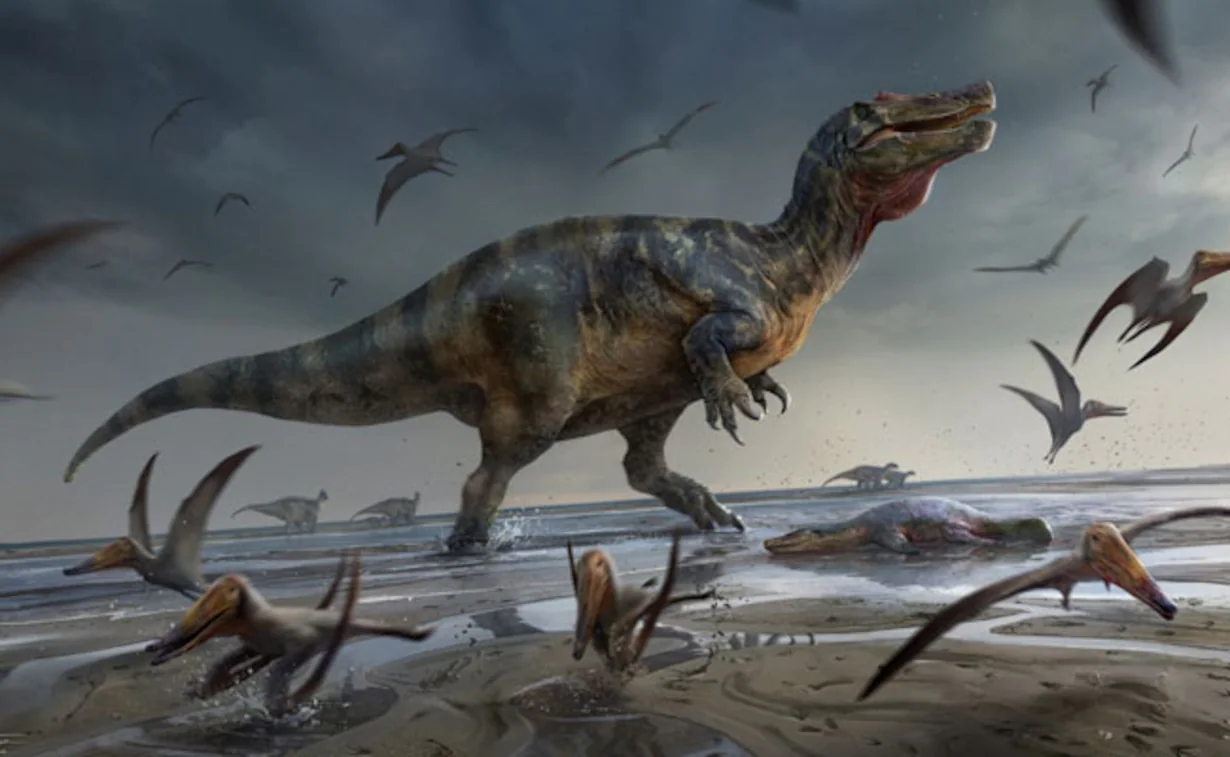
Dinosaurs are one of the most fascinating creatures to have ever roamed the Earth. They were huge, and fierce, and dominated the planet for millions of years. However, despite their impressive size and strength, dinosaurs eventually disappeared from the face of the Earth.
But what if we told you that some dinosaurs actually survived and evolved into something even more remarkable? That’s right – birds! In this article, we’ll explore how dinosaurs shrank over time and eventually became birds as we know them today. We’ll delve into the latest scientific research on this topic and learn about some of the key theories behind this incredible transformation. So sit back, grab a cup of tea, and get ready to discover how these prehistoric giants turned into feathered friends.
From giants to feathered friends
The fossil record shows that dinosaurs shrank in size over millions of years and eventually evolved into the birds we know today. One theory suggests that this shrinkage was due to a change in diet and habitat, as smaller creatures were better adapted to living in trees. As they became smaller, these creatures developed feathers for warmth and gliding, which eventually led to flight.
Another key factor in the evolution from dinosaur to bird was the development of a more efficient respiratory system. Birds have air sacs that allow them to extract oxygen from their environment more efficiently than other animals. This adaptation allowed them to fly higher and longer than any other creature on Earth.
Today’s birds are incredibly diverse, with over 10,000 known species worldwide. From tiny hummingbirds to giant ostriches, each species has its own unique adaptations for survival. Some birds can dive underwater for several minutes while others use tools to find food or build nests. Despite their differences, all birds share a common ancestry with dinosaurs and are a testament to the resilience of life on Earth over millions of years.
Dinosaur-Bird Connection:
Scientists have long believed that birds evolved from a group of small, feathered dinosaurs known as theropods. However, recent studies have shed light on the process by which these creatures transitioned from being massive and earthbound to small and able to fly. One key factor appears to be changed in their bone structure, as the bones of early birds became lighter and more flexible over time.
Another important factor was the development of feathers, which likely helped these creatures stay warm and provided a means of gliding through the air before they were capable of full-fledged flight. These feathers also played a role in courtship displays and other social behaviors that allowed birds to form complex societies and ultimately dominate many ecosystems around the world.
Overall, the dinosaur-bird connection is an exciting area of study that continues to yield fascinating insights into how life on Earth has evolved over millions of years. By understanding this connection, researchers can better understand both ancient history and modern biology alike.
Evolutionary links and similarities
One of the most fascinating evolutionary links is the connection between dinosaurs and modern birds. It’s widely accepted that birds descended from theropod dinosaurs, such as Tyrannosaurus rex and Velociraptor. Over time, these carnivorous beasts evolved into smaller and more agile creatures, developing feathered wings to help them glide from tree to tree in pursuit of prey.
The process by which these once-ferocious predators shrank down into the songbirds we know today is known as miniaturization. Essentially, natural selection favored those who could survive on smaller amounts of food – leading to a reduction in body size over time. But it wasn’t just their bodies that changed; their skeletal structure underwent significant modifications as well. For example, their ribcage became more flexible to allow for greater lung capacity needed for flight.
Overall, it’s amazing to consider how much evolution can alter the course of life on Earth – turning giant reptiles with razor-sharp teeth into delicate creatures that sing sweetly in our backyards. And while there are still many mysteries left to uncover about this ancient lineage, one thing is clear: the evolutionary links between dinosaurs and birds continue to fascinate scientists and inspire us all with wonder at the complexity and diversity of life on our planet.
Anatomy Changes:
One of the most fascinating aspects of the evolution of birds is how their anatomy changed over time. For example, scientists have discovered that many modern bird species evolved from dinosaurs that shrank in size over millions of years. As these creatures became smaller and lighter, they also developed changes to their skeletons and muscles that allowed them to become better adapted for flight.
One key change was the evolution of feathers, which provided insulation and helped with balance during flight. Birds also developed hollow bones, reduced tails, and more efficient respiratory systems with air sacs. These anatomical changes allowed birds to achieve incredible feats such as soaring high in the sky for hours on end or diving deep into water without any difficulty.
Overall, studying these anatomical changes sheds light on how organisms can adapt to new environments through natural selection. It’s fascinating to think about how something as simple as shrinking in size could lead to such complex changes in an organism’s body structure and behavior.
Adaptations for flight and size reduction
One of the most fascinating adaptations for flight and size reduction is seen in the evolution of birds from dinosaurs. Over time, some dinosaurs developed lightweight bodies with feathers that allowed them to glide through the air. These early gliders eventually evolved into true flyers, developing wings and other specialized features such as a keeled sternum for muscle attachment and a reduced tail to aid in balance.
Another major adaptation for flight and size reduction in birds is their respiratory system. Unlike mammals, which have a diaphragm to breathe, birds have air sacs that allow for continuous oxygen exchange during both inhaling and exhaling. This unique system enables birds to extract more oxygen from each breath, allowing them to fly at higher altitudes where there is less available oxygen.
Overall, the adaptations for flight and size reduction seen in the evolution of birds from dinosaurs were crucial in enabling these creatures to survive and thrive in their environments. These adaptations not only allowed them to take advantage of new food sources but also helped protect them from predators by allowing them to escape quickly into the sky.
Fossil Evidence:
Fossil evidence has played a crucial role in understanding the evolution of dinosaurs into birds. Paleontologists have been able to trace the lineage of modern birds back to feathered theropod dinosaurs from the Jurassic period. The discovery of fossilized feathers and bone structures that indicated flight capabilities confirmed this theory.
Additionally, researchers have found that many dinosaur species underwent a process called miniaturization, which involved shrinking in size over time. This is believed to be one of the key factors that led to their eventual transition into birds. As dinosaurs shrank, their body proportions changed, with longer arms and shorter tails – adaptations that would eventually allow them to fly.
Overall, fossils provide tangible evidence for the gradual changes that occurred over millions of years during the evolution from dinosaurs to birds. These findings help us understand not only how these fascinating creatures lived and adapted but also how species can evolve and adapt over long periods of time.
Discoveries that support the theory
Recent discoveries have provided compelling evidence to support the theory that birds evolved from dinosaurs. Fossilized remains of feathered dinosaurs, such as the Archaeopteryx, have been found in China and Germany. These fossils show a clear transitional form between reptiles and birds, with feathers, wings, and a beak-like mouth.
Additionally, studies of bird embryos have revealed that they develop similarly to dinosaur embryos. Both groups grow long tails during development before ultimately shortening them into a tailbone. This suggests that the genetic blueprint for bird development was inherited from their dinosaur ancestors.
Lastly, molecular analysis of DNA has shown that many genes associated with bird traits are also present in non-avian dinosaurs. For example, the gene for keratin (the protein found in feathers) exists in both modern birds and certain theropod dinosaurs like Velociraptors.
In conclusion, these recent discoveries provide strong evidence supporting the theory that birds evolved from small carnivorous theropod dinosaurs millions of years ago.
Challenges to the Theory:
One of the main challenges to the theory that dinosaurs shrank and became birds is the lack of fossil evidence. While there are plenty of fossils that show some dinosaurs had feathers, there is still much debate over which species are direct ancestors of modern birds. Some scientists argue that certain bird-like dinosaurs, such as Velociraptors or Archaeopteryx, were transitional forms between non-avian dinosaurs and modern birds. Others contend that these animals were separate branches on the evolutionary tree.
Another challenge to the theory is how flight evolved in birds. To fly, animals must have lightweight bones and powerful muscles capable of producing lift. However, many early bird-like dinosaurs had heavy bones and lacked the specialized anatomy needed for powered flight. Some researchers believe that these creatures may have glided from trees or other high places before evolving true powered flight.
Despite these challenges, most paleontologists agree that modern birds descended from some type of theropod dinosaur. With new discoveries being made all the time, it’s only a matter of time before we discover more about how these fascinating creatures evolved into one of Earth’s most diverse groups of animals.
Opposing views and controversies
Opposing views and controversies surround the theory of how dinosaurs shrank and evolved into birds. Some scientists argue that feathered dinosaurs are not direct ancestors of modern-day birds but rather a separate branch of the dinosaur family tree. They also believe that the evolution from small, feathered theropod dinosaurs to modern-day birds was a gradual process over millions of years, rather than a sudden transformation.
Another controversy is whether or not all dinosaurs had feathers. While fossil evidence has shown that many theropods were covered in feathers, some researchers argue that other types of dinosaurs may have had different forms of insulation such as scales or fur. Additionally, there is debate over whether flight evolved once or multiple times within the dinosaur lineage.
Despite these opposing views and controversies, research continues to reveal new insights into the evolution of birds from their dinosaur ancestors. As more fossils are discovered and analyzed, it is likely that our understanding will continue to evolve as well.
Conclusion:
In conclusion, the evolution of dinosaurs into birds is a fascinating process that has been studied for many years. The transformation from large, reptilian creatures to small, feathered flyers was a gradual one that took millions of years. While there are still some unanswered questions about the exact process and timeline of this evolution, scientists have made significant strides in understanding it.
One aspect that is clear is that feathers played a crucial role in the transition from dinosaurs to birds. Not only did they provide insulation and aid in flight, but they also served as displays for courtship and communication. Additionally, changes in bone structure allowed for lighter bodies and more efficient movement.
Overall, the evolution of dinosaurs into birds provides valuable insights into how species adapt and change over time. It is an example of natural selection at work and serves as a reminder of the incredible diversity and complexity present in our world’s ecosystems.
Despite debates, evidence points to evolution
The theory of evolution has been debated for centuries, yet evidence continues to point toward its validity. One example is the study of how dinosaurs shrank and eventually evolved into birds. The fossil record shows a clear transition from small, feathered dinosaurs to early bird species. Additionally, genetic studies have revealed similarities between modern birds and their dinosaur ancestors.
One common argument against evolution is the lack of transitional fossils. However, the discovery of numerous intermediate forms in recent years has helped fill in gaps in the fossil record and provide further evidence for evolution. In fact, the existence of these transitional species supports evolutionary theory by demonstrating gradual changes over time rather than sudden appearances.
Overall, while debates about evolution may continue, scientific evidence overwhelmingly supports its occurrence. The study of how dinosaurs evolved into birds serves as just one example of this phenomenon and highlights the importance of continued research and exploration in understanding our planet’s history and natural processes.
Read Also… how-to-write-a-haiku-in-4-easy-steps







